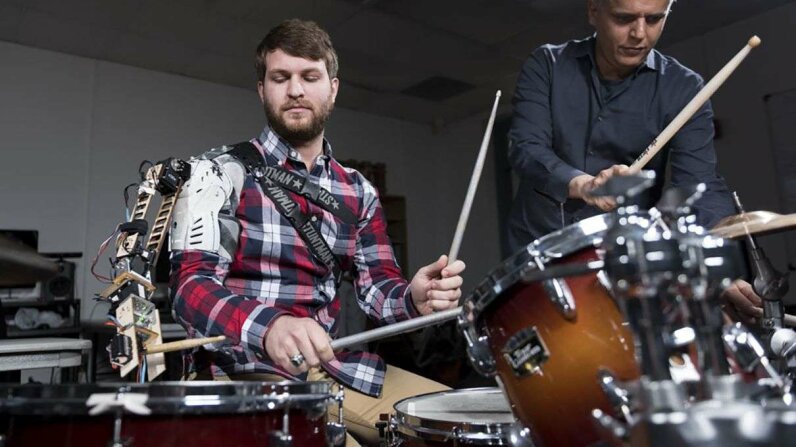
A new robotic prosthesis can augment drummers with an extra arm GEORGIA TECH
Drummers get a raw deal. Ringo Starr may the most recognizable man behind the high hats, but he’s still the world’s fourth favorite Beatle. Tommy Lee is widely considered one of the greatest time keepers in rock history, yet most people didn’t know his name until a certain “Baywatch” flavored video hit the internet. Even Dave Grohl, one of the nicest men in music, had to step out from behind the drum kit before he become a certified rock star.
So drumming might not be as glamorous shredding a guitar or singing sweet nothings into a mic. It is pretty difficult, however. There’s a certain kind of physical talent required to kick the pedals, pound the snare and tickle the toms all at the same time, not to mention doing each at a different pace. The good news for drummers is that smart technology might soon make playing percussion a little bit easier.0:10
Engineers at Georgia Tech are developing a prosthetic arm that not only keeps up with, but also complements drummers in real time. The biomechatronic device attaches to a drummer’s shoulder to add a third arm that responds to the music and motions around it. The robot drumming device can also improvise as it plays, and future iterations may eventually know its users so well that it can read brain waves to sense where the music is going next.
Professor Gil Weinberg and a group of students came up with the idea after building a more basic prosthetic drumming arm for an Atlanta musician who lost a limb in an electrocution accident. The device uses a motor to power two drum sticks — one controlled by the user through electromyography muscle sensors and the other with a mind of its own. Check out that earlier prosthesis in action in the video below.
The updated version features accelerometers that tell the arm how close it is to the drum set and lets it know when to change angles and reach. The arm also recognizes a drummer’s gestures and senses the speed and style of play to respond accordingly.
“If you have a robotic device that is part of your body, it’s a completely different feeling from working alongside a regular robot,” says Weinberg. “The machine learns how your body moves and can augment and complement your activity. It becomes a part of you.”
The goal is to make the prosthesis act like an actual part of the human player. That effort would take a big step forward if Weinberg & Co. can figure out how to link the robot arm to real human brain activity. They’re currently tinkering with an electroencephalogram (EEG) headband that reads a user’s brain waves. The idea is to detect patterns that would signal the prosthesis before changes in patter and tempo happen. A successful drumming robot could provide the groundwork for other robotic third-arm helpers with medical, military and construction applications, among others. NOW THAT’S INTERESTING The Ludwig Drum Company created and sold the first bass drum pedal in 1909, revolutionizing drumming by freeing up users’ arms to play other percussion instruments.
